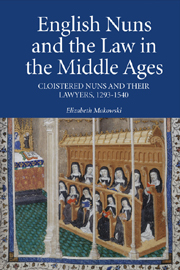Book contents
- Frontmatter
- Contents
- Preface
- Acknowledgments
- List of Abbreviations
- Introduction
- I Clients and Lawyers
- 1 Cloistered Spirituality and English Nuns
- 2 Legal Professionalism and English Lawyers
- 3 Letters of Appointment and Routine Business
- II Select Cases
- Conclusion
- Appendix
- Select Bibliography
- Index
- Titles in the series
2 - Legal Professionalism and English Lawyers
from I - Clients and Lawyers
Published online by Cambridge University Press: 05 April 2013
- Frontmatter
- Contents
- Preface
- Acknowledgments
- List of Abbreviations
- Introduction
- I Clients and Lawyers
- 1 Cloistered Spirituality and English Nuns
- 2 Legal Professionalism and English Lawyers
- 3 Letters of Appointment and Routine Business
- II Select Cases
- Conclusion
- Appendix
- Select Bibliography
- Index
- Titles in the series
Summary
Courts, Procedure, and Personnel
By the end of the thirteenth century, professional lawyers were routinely litigating in English ecclesiastical and secular courts. The jurisdictional divisions between common law and church courts, and the distinctive procedural law under which each set of courts operated had also been established by this time. There were, in fact, two legal professions. Romano-canonical lawyers trained in universities and working in the continental tradition known as the ius commune had degrees (bachelor, licentiate, doctor) and practiced as proctors and advocates in the ecclesiastical courts in England, in Chancery, and at the Papal Curia. Common law lawyers were trained in Common Pleas and at the Inns of Court, and then practiced as attorneys, pleaders, and serjeants in all the royal common law courts, central and local. Both types of legal professionals were essential to English litigants who might find themselves required to plead in either type of court at home or, by virtue of an appeal, in the Roman curia. In this chapter, I deal with aspects of professionalization of the English legal system that relate to the individuals and cases to be encountered in the second section of this book.
- Type
- Chapter
- Information
- English Nuns and the Law in the Middle AgesCloistered Nuns and their Lawyers, 1293–1540, pp. 29 - 54Publisher: Boydell & BrewerPrint publication year: 2012



